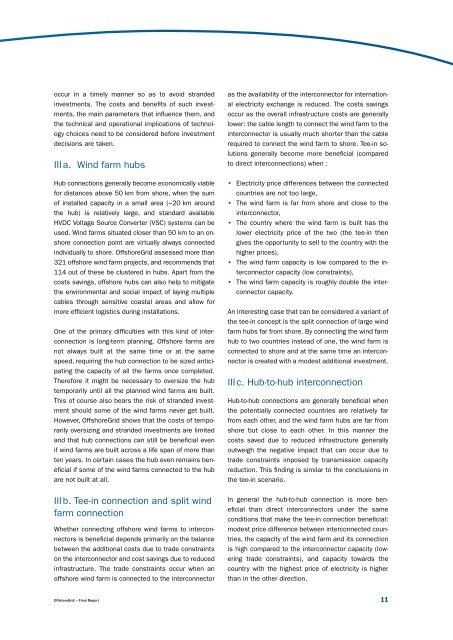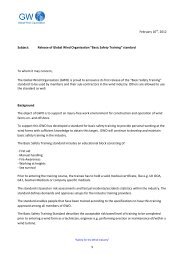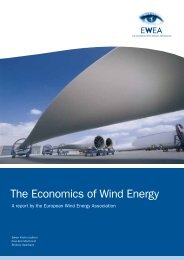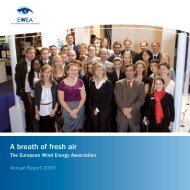Offshore Electricity Infrastructure in Europe - European Wind Energy ...
Offshore Electricity Infrastructure in Europe - European Wind Energy ...
Offshore Electricity Infrastructure in Europe - European Wind Energy ...
You also want an ePaper? Increase the reach of your titles
YUMPU automatically turns print PDFs into web optimized ePapers that Google loves.
occur <strong>in</strong> a timely manner so as to avoid stranded<br />
<strong>in</strong>vestments. The costs and benefits of such <strong>in</strong>vestments,<br />
the ma<strong>in</strong> parameters that <strong>in</strong>fluence them, and<br />
the technical and operational implications of technology<br />
choices need to be considered before <strong>in</strong>vestment<br />
decisions are taken.<br />
III a. W<strong>in</strong>d farm hubs<br />
Hub connections generally become economically viable<br />
for distances above 50 km from shore, when the sum<br />
of <strong>in</strong>stalled capacity <strong>in</strong> a small area (~20 km around<br />
the hub) is relatively large, and standard available<br />
HVDC Voltage Source Converter (VSC) systems can be<br />
used. W<strong>in</strong>d farms situated closer than 50 km to an onshore<br />
connection po<strong>in</strong>t are virtually always connected<br />
<strong>in</strong>dividually to shore. <strong>Offshore</strong>Grid assessed more than<br />
321 offshore w<strong>in</strong>d farm projects, and recommends that<br />
114 out of these be clustered <strong>in</strong> hubs. Apart from the<br />
costs sav<strong>in</strong>gs, offshore hubs can also help to mitigate<br />
the environmental and social impact of lay<strong>in</strong>g multiple<br />
cables through sensitive coastal areas and allow for<br />
more efficient logistics dur<strong>in</strong>g <strong>in</strong>stallations.<br />
One of the primary difficulties with this k<strong>in</strong>d of <strong>in</strong>terconnection<br />
is long-term plann<strong>in</strong>g. <strong>Offshore</strong> farms are<br />
not always built at the same time or at the same<br />
speed, requir<strong>in</strong>g the hub connection to be sized anticipat<strong>in</strong>g<br />
the capacity of all the farms once completed.<br />
Therefore it might be necessary to oversize the hub<br />
temporarily until all the planned w<strong>in</strong>d farms are built.<br />
This of course also bears the risk of stranded <strong>in</strong>vestment<br />
should some of the w<strong>in</strong>d farms never get built.<br />
However, <strong>Offshore</strong>Grid shows that the costs of temporarily<br />
oversiz<strong>in</strong>g and stranded <strong>in</strong>vestments are limited<br />
and that hub connections can still be beneficial even<br />
if w<strong>in</strong>d farms are built across a life span of more than<br />
ten years. In certa<strong>in</strong> cases the hub even rema<strong>in</strong>s beneficial<br />
if some of the w<strong>in</strong>d farms connected to the hub<br />
are not built at all.<br />
III b. Tee-<strong>in</strong> connection and split w<strong>in</strong>d<br />
farm connection<br />
Whether connect<strong>in</strong>g offshore w<strong>in</strong>d farms to <strong>in</strong>terconnectors<br />
is beneficial depends primarily on the balance<br />
between the additional costs due to trade constra<strong>in</strong>ts<br />
on the <strong>in</strong>terconnector and cost sav<strong>in</strong>gs due to reduced<br />
<strong>in</strong>frastructure. The trade constra<strong>in</strong>ts occur when an<br />
offshore w<strong>in</strong>d farm is connected to the <strong>in</strong>terconnector<br />
<strong>Offshore</strong>Grid – F<strong>in</strong>al Report<br />
as the availability of the <strong>in</strong>terconnector for <strong>in</strong>ternational<br />
electricity exchange is reduced. The costs sav<strong>in</strong>gs<br />
occur as the overall <strong>in</strong>frastructure costs are generally<br />
lower: the cable length to connect the w<strong>in</strong>d farm to the<br />
<strong>in</strong>terconnector is usually much shorter than the cable<br />
required to connect the w<strong>in</strong>d farm to shore. Tee-<strong>in</strong> solutions<br />
generally become more beneficial (compared<br />
to direct <strong>in</strong>terconnections) when :<br />
• <strong>Electricity</strong> price differences between the connected<br />
countries are not too large,<br />
• The w<strong>in</strong>d farm is far from shore and close to the<br />
<strong>in</strong>terconnector,<br />
• The country where the w<strong>in</strong>d farm is built has the<br />
lower electricity price of the two (the tee-<strong>in</strong> then<br />
gives the opportunity to sell to the country with the<br />
higher prices),<br />
• The w<strong>in</strong>d farm capacity is low compared to the <strong>in</strong>terconnector<br />
capacity (low constra<strong>in</strong>ts),<br />
• The w<strong>in</strong>d farm capacity is roughly double the <strong>in</strong>terconnector<br />
capacity.<br />
An <strong>in</strong>terest<strong>in</strong>g case that can be considered a variant of<br />
the tee-<strong>in</strong> concept is the split connection of large w<strong>in</strong>d<br />
farm hubs far from shore. By connect<strong>in</strong>g the w<strong>in</strong>d farm<br />
hub to two countries <strong>in</strong>stead of one, the w<strong>in</strong>d farm is<br />
connected to shore and at the same time an <strong>in</strong>terconnector<br />
is created with a modest additional <strong>in</strong>vestment.<br />
III c. Hub-to-hub <strong>in</strong>terconnection<br />
Hub-to-hub connections are generally beneficial when<br />
the potentially connected countries are relatively far<br />
from each other, and the w<strong>in</strong>d farm hubs are far from<br />
shore but close to each other. In this manner the<br />
costs saved due to reduced <strong>in</strong>frastructure generally<br />
outweigh the negative impact that can occur due to<br />
trade constra<strong>in</strong>ts imposed by transmission capacity<br />
reduction. This f<strong>in</strong>d<strong>in</strong>g is similar to the conclusions <strong>in</strong><br />
the tee-<strong>in</strong> scenario.<br />
In general the hub-to-hub connection is more beneficial<br />
than direct <strong>in</strong>terconnectors under the same<br />
conditions that make the tee-<strong>in</strong> connection beneficial:<br />
modest price difference between <strong>in</strong>terconnected countries,<br />
the capacity of the w<strong>in</strong>d farm and its connection<br />
is high compared to the <strong>in</strong>terconnector capacity (lower<strong>in</strong>g<br />
trade constra<strong>in</strong>ts), and capacity towards the<br />
country with the highest price of electricity is higher<br />
than <strong>in</strong> the other direction.<br />
11









